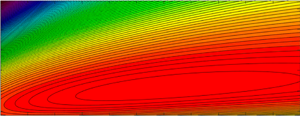Published online by Cambridge University Press: 24 July 2020

The flow in a channel having walls with periodic undulations of small amplitude  $\epsilon$ in the streamwise direction is considered as a model for wall roughness. It is shown that the undulations act as a catalyst to allow a new instability related to vortex–wave interactions to grow. The roughness couples a wave disturbance with a roll–streak flow and it is shown that channel flows, both wall and pressure gradient driven, are unstable when the Reynolds number exceeds a critical value proportional to
$\epsilon$ in the streamwise direction is considered as a model for wall roughness. It is shown that the undulations act as a catalyst to allow a new instability related to vortex–wave interactions to grow. The roughness couples a wave disturbance with a roll–streak flow and it is shown that channel flows, both wall and pressure gradient driven, are unstable when the Reynolds number exceeds a critical value proportional to  ${\epsilon ^{-({3}/{2})} [\vert {\log \epsilon }\vert ]^{-({3}/{4})}}$, the constant of proportionality depending on the wall wavelengths and amplitudes. The roughness is an integral part of the instability mechanism and not simply the seed for an existing flow instability as in receptivity theory. The mechanism involves an interaction of the rolls, streaks and waves very similar to that in vortex–wave interaction theory but now facilitated by the wall roughness. Surprisingly, the subtle interaction between waves, rolls, streaks and the walls can be solved in closed form, and an explicit form for the neutral configuration is found. The theoretical predictions are in good agreement with numerical investigations of similar problems and are applicable to a wide range of shear flows.
${\epsilon ^{-({3}/{2})} [\vert {\log \epsilon }\vert ]^{-({3}/{4})}}$, the constant of proportionality depending on the wall wavelengths and amplitudes. The roughness is an integral part of the instability mechanism and not simply the seed for an existing flow instability as in receptivity theory. The mechanism involves an interaction of the rolls, streaks and waves very similar to that in vortex–wave interaction theory but now facilitated by the wall roughness. Surprisingly, the subtle interaction between waves, rolls, streaks and the walls can be solved in closed form, and an explicit form for the neutral configuration is found. The theoretical predictions are in good agreement with numerical investigations of similar problems and are applicable to a wide range of shear flows.